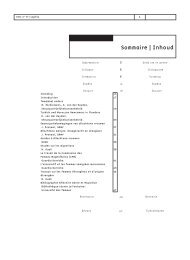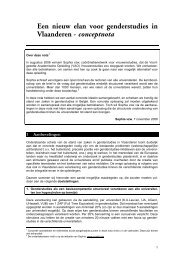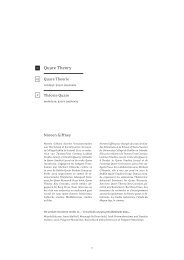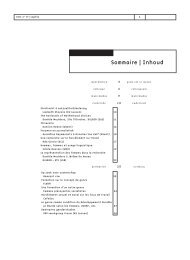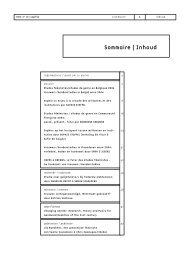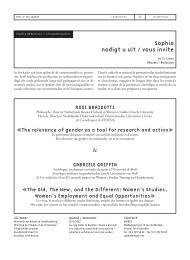Nieuwsbrief 32 (pdf) - Sophia
Nieuwsbrief 32 (pdf) - Sophia
Nieuwsbrief 32 (pdf) - Sophia
Create successful ePaper yourself
Turn your PDF publications into a flip-book with our unique Google optimized e-Paper software.
echerche 40 onderzoek<br />
sophia | n° <strong>32</strong> | 2002<br />
tively descriptive, i.e. that the parliamentarians<br />
mirror the voters’ opinions.<br />
The assumption is that in those countries<br />
having an electoral system that promotes<br />
proportionality and results in a<br />
parliament having a wide variety of views<br />
and experiences, the levels of issue congruence<br />
will be higher than in those countries<br />
having electoral systems that promote<br />
accountability, and results in an<br />
assembly with less diversity. If the parliamentarians<br />
social background influences<br />
their views, then it can be expected<br />
that a parliament, which to a larger<br />
degree, mirrors the voter’s characteristics,<br />
will also be more representative of the<br />
voter’s opinions. Along these lines, and if<br />
similar social backgrounds result in similar<br />
views, then it can be assumed that<br />
female parliamentarians as compared to<br />
male legislators will be more representative<br />
of female voters.<br />
Empirical evidences show that the electoral<br />
system’s level of proportionality does<br />
influence the extent to which assemblies<br />
socially and ideologically mirror their<br />
population. For the cases examined, the<br />
increase of the proportionality, and therefore<br />
of the descriptive representativeness<br />
of the parliament, has resulted in an<br />
increase in the levels of congruence between<br />
its members and the electorate. Not<br />
only that, but it has been shown that<br />
more sex-balanced parties tend to be more<br />
representative of their voter’s opinions.<br />
Finally, a striking finding is that lower<br />
levels of congruence are observed between<br />
female legislators and voters, than<br />
between male legislators and voters. Three<br />
possible hypotheses are here advanced,<br />
setting up guidelines for future research.<br />
Firstly, it might be possible that a tougher<br />
selection process for female candidates<br />
could result on a more ‘exceptional’<br />
representative body than that of their<br />
male counterparts, and therefore on a less<br />
representative one. This background<br />
explanation brings in the idea of intersectionality,<br />
i.e. that as social groups,<br />
women and men ought to be considered<br />
in the heterogeneity that results in the<br />
intersection with other factors such as<br />
age, race or social class. Along these lines<br />
it has been argued that, if the possibilities<br />
of reaching power positions are much<br />
lower for working class as compared to<br />
upper class men, then the process for a<br />
woman is even tougher, since to the difficulty<br />
of class, one must add that of gender.<br />
This is in line with the idea that<br />
women ought to compensate the sexdisadvantage<br />
to a higher extent than men,<br />
by accumulating social and cultural<br />
resources (Sineau, 2001). In other words,<br />
the chances to get a social bias among<br />
women representatives are higher than<br />
among men, and therefore the likelihood<br />
of more representativity, due to diversification<br />
in terms of social background<br />
are lower among female as opposed to<br />
male MPs.<br />
Secondly, and quoting a Belgian Member<br />
of Parliament, one can say that today,<br />
more than ever, the issues are defined in<br />
terms of priorities concerning very specific<br />
matters. It is therefore essential for parties<br />
to define clearly their positions on those<br />
issues. In this respect, some scholars have<br />
stressed the fact that parties are subject to<br />
‘functional necessities’ when they define<br />
their positions. Following the same line<br />
of thinking, one could envisage that there<br />
are also ‘functional necessities’ for<br />
women to ‘make more differentiated<br />
appeals in order to present clear policy<br />
proposals and thus gain support’ (Holmberg,<br />
2001:2). Thus, since women are<br />
relatively new actors in parliaments, they<br />
need to send clear messages of what they<br />
are standing for, and make themselves<br />
clearly distinct from other legislators.<br />
For example, the evolution observed in<br />
Sweden during the 1990s, towards a high<br />
similarity in the way in which male and<br />
female legislators mirror the voter’s opinions,<br />
can be an indicator of the former<br />
hypothesis. Two decades may have reduced<br />
the necessity for the Swedish female<br />
parliamentarians to make themselves clearly<br />
distinct in relation to their male counterparts.<br />
Finally, and if ‘democracy is not just a<br />
process of registering and reflecting opinion<br />
but also of forming and changing it’<br />
(Esaiasson & Holmberg, 1996:111-112),<br />
could it be assumed that new legislators,<br />
as opposed to established groups of actors,<br />
tend to be less congruent with the electorate<br />
because they are trying to form<br />
and change opinion, more than just<br />
registering and reflecting it?<br />
Final thoughts<br />
The book discusses two types of theoretical<br />
arguments for sex-balanced parliaments,<br />
i.e. rights and utility arguments.<br />
The first type of arguments simply claims<br />
that an equal number of men and women<br />
is a right, whereas utility arguments claim<br />
that parliaments ought to be sex-balanced<br />
because it is useful, not because it is fair<br />
and just. Some of these arguments suggest<br />
that the utility of diversifying the res<br />
publica comes from those groups' capacity<br />
of change, which therefore leads to<br />
the empirical question if, how and when<br />
women or new actors in general have an<br />
impact on the overall political process.<br />
In line with these arguments, one observes<br />
that the equilibrium in terms of sexcomposition<br />
of the legislative assemblies<br />
is important because it carries an improvement<br />
of the working conditions related<br />
to minority and majority attitudes, an<br />
impact on the parliamentary and policymaking<br />
processes, and a better representation<br />
(measured as issue agreement between<br />
voters and members of parliament).<br />
However, the danger of expecting changes<br />
from women MPs (among other new<br />
actors asking for a higher involvement in<br />
the political process), relying on the benefit<br />
that one group can bring into politics,<br />
is a backlash. In this train of thought one<br />
Swedish male MP from the social democratic<br />
party mentioned that:<br />
When we had the election in 1994 the<br />
discussion was about quota: we should<br />
have more women in parliament, and so<br />
on. And now, I can hear more and more<br />
from the remaining male politicians of<br />
the old fashion, that this was not that<br />
great idea: ‘what has it actually changed?’<br />
When the Swedish and Belgian legislators




